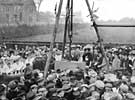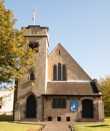For this church:    |
|
 Laying the foundation Laying the foundationstone, 1908 Image courtesy of The Old Mansfield Society |
In the 1880s the population of Mansfield was expanding particularly into the areas to the north-east of the town where coal mining was a developing industry. To cater for the new community, a brick building known as the School Room and Mission Room was erected in 1887 on the corner of Newgate Lane and Sandy Lane. By 1894 the growing congregation needed more space and a piece of land was purchased to build a larger church. This land proved to be unsatisfactory and was resold. It was to be several years before a new site at the junction of Sandy Lane and Peck lane was purchased and the foundation stone of the new church was laid by the Duchess of Portland on 28 October 1908.
The design of the building was entrusted to a local firm of architects, Robert Frank Valance and Louis Alfred Westwick of Mansfield. The estimated cost was £3,025 of which £2,675 had been raised by the church before it was consecrated by the Bishop of Southwell on 5 September 1909. It was proposed that the new building would accommodate a congregation of 537: 200 in the nave, 200 in each of the side aisles and 32 in the choir; but the plans were changed to eliminate the side aisles, leaving only a central aisle with seating reduced to 350. All the seats were free. At the time the church was consecrated the population of the proposed new parish was given as 10,000. It was not until 19 July 1921 that St. Lawrence’s became a separate parish.
There can be little doubt regarding the demand for the new church. Records show that in its first year, 440 children were attending the Sunday school, 80 children were baptised and 11 confirmations took place. In 1914 a Church Hall was built to give additional accommodation, followed in 1921 by the purchase and erection of an ex-army hut on Skerry Hill to meet the continuing growth. Building did not stop: in 1923 the same firm of architects were commissioned to design a new vicarage on nearby Newgate. The building, which is extant, cost £2,800. A fire in 1970 destroyed the wooden church hall (it is not clear if this was the 1914 building). This gave the church the opportunity to build a modern structure in 1980, which remains in use today.
Some years ago the church purchased a former Wesleyan Chapel on Skerry Hill. It was renamed ‘The Treasury’ and in 2015 was used for many activities including the Brownies and Guides, and a community café.
An examination of the church records for the 1930s shows how the church continued to be well used. Baptisms in 1931 totalled 93, and whilst they did reduce towards the end of the decade, 77 children were baptised in 1939. Adult baptisms were also recorded with an average of four per year from 1931-9. In the same period Easter Day communion saw the church very well attended, with 360 communicants in 1931 and 300 in 1932, with a slowly reducing number to 246 in 1939.
The church registers for Baptisms and Marriages are lodged in Nottinghamshire Archives.






